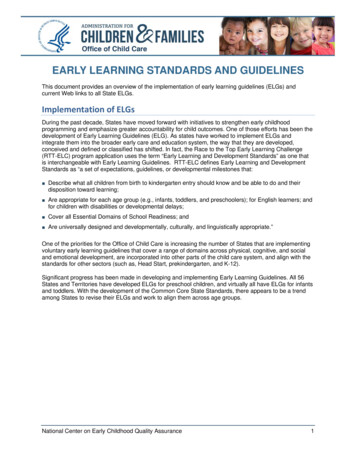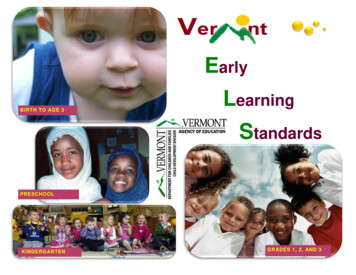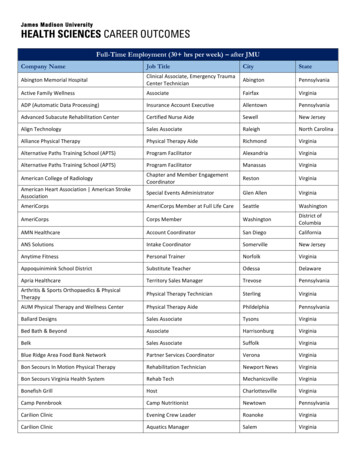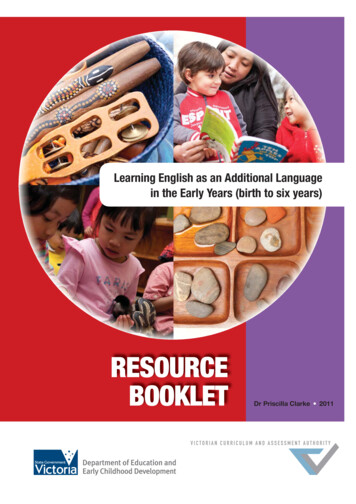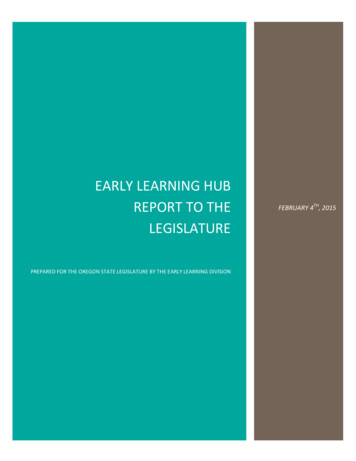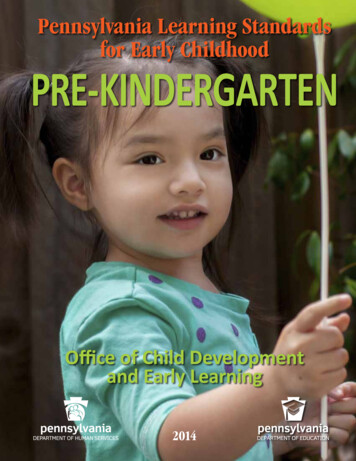
Transcription
Pennsylvania Learning Standardsfor Early ChildhoodPRE-KINDERGARTENOffice of Child Developmentand Early Learning2014
TABLE OF CONTENTSIntroduction. . . . . . . . . . . . . . . . . . . . . . . . . . . . . . . . . . . . . . . . . . . . . . . . . . . . . . . . . . . . . . . . . . . . . . . . . . . 4The Learning Standards Continuum. . . . . . . . . . . . . . . . . . . . . . . . . . . . . . . . . . . . . . . . . . . . . . . . . . . . . . . . . 7Guiding Principles. . . . . . . . . . . . . . . . . . . . . . . . . . . . . . . . . . . . . . . . . . . . . . . . . . . . . . . . . . . . . . . . . . . . . . . 8KEY LEARNING AREA: Approaches to Learning through Play – Constructing, Organizing,and Applying KnowledgeStandard Area AL.1: Constructing and Gathering Knowledge 11Standard Area AL.2: Organizing and Understanding Information 12Standard Area AL.3: Applying Knowledge 14Standard Area AL.4: Learning through Experience 15Approaches to Learning Glossary 17KEY LEARNING AREA: Language and Literacy Development – English Language ArtsStandard Area 1.1: Foundational Skills 19Standard Area 1.2: Reading Informational Text 20Standard Area 1.3: Reading Literature 23Standard Area 1.4: Writing 26Standard Area 1.5: Speaking and Listening 29Language and Literacy Development Glossary 31KEY LEARNING AREA: Mathematical Thinking and Expression – Exploring, Processing, andProblem-SolvingStandard Area 2.1: Numbers and Operations 34Standard Area 2.2: Algebraic Concepts 35Standard Area 2.3: Geometry 36Standard Area 2.4: Measurement, Data, and Probability 38Mathematical Thinking and Expression Glossary 40KEY LEARNING AREA: Scientific Thinking and Technology – Exploring, Scientific Inquiry,and DiscoveryStandard Area 3.1A: Biological Sciences – Living and Non-Living Organisms 42Standard Area 3.1B: Biological Sciences – Genetics 43Standard Area 3.1C: Biological Sciences – Evolution 44Standard Area 3.2A: Physical Sciences – Chemistry 44Standard Area 3.2B: Physical Sciences – Physics 45Standard Area 3.3A: Earth and Space Sciences – Earth Structures, Processes, and Cycles 47Standard Area 3.3B: Earth and Space Sciences – Origin and Evolution of the Universe 48Standard Area 4.1: Environment and Ecology – Ecology 49Standard Area 4.2: Environment and Ecology – Watersheds and Wetlands 50Standard Area 4.3: Environment and Ecology – Natural Resources 50Standard Area 4.4: Environment and Ecology – Agriculture and Society 51Standard Area 4.5: Environment and Ecology – Humans and the Environment 51Standard Area 15.4: Computer and Information Technology 52Scientific Thinking Glossary 55Environment and Ecology Glossary 55Computer and Information Technology Glossary 562
KEY LEARNING AREA: Social Studies Thinking – Connecting to CommunitiesStandard Area 5.1: Civics and Government – Principles and Documents of Government 58Standard Area 5.2: Civics and Government – Rights and Responsibilities of Citizenship 58Standard Area 5.3: Civics and Government – How Government Works 59Standard Area 6.1: Economics – Scarcity and Choice 60Standard Area 6.2: Economics – Markets and Economic Systems 60Standard Area 6.3: Economics – Functions of Government 61Standard Area 6.5: Economics – Income, Profit, and Wealth 61Standard Area 7.1: Geography – Basic Geographic Literacy 62Standard Area 7.2: Geography – Physical Characteristics of Places and Regions 62Standard Area 8.1: History – Historical Analysis and Skills Development 63Social Studies Thinking Glossary 64KEY LEARNING AREA: Creative Thinking and Expression – Communicating through the ArtsStandard Area 9.1M: Production and Performance – Music and Movement 66Standard Area 9.1D: Production and Performance – Dramatic and Performance Play 67Standard Area 9.1V: Production and Performance – Visual Arts 68Standard Area 9.2: Historical and Cultural Context of Works in the Arts 69Standard Area 9.3: Critical Response to Works in the Arts 69Standard Area 9.4: Aesthetic Response to Works in the Arts 70Creative Thinking and Expression Glossary 70KEY LEARNING AREA: Health, Wellness, and Physical Development – Learning About MyBodyStandard Area 10.1: Concepts of Health 72Standard Area 10.2: Healthful Living 73Standard Area 10.3: Safety and Injury Prevention 74Standard Area 10.4: Physical Activity – Gross Motor Coordination 74Standard Area 10.5: Concepts, Principles, and Strategies of Movement – Fine Motor Coordination 75Health, Wellness, and Physical Development Glossary 77KEY LEARNING AREA: Social and Emotional Development – Student Interpersonal SkillsStandard Area 16.1: Self-Awareness and Self-Management 79Standard Area 16.2: Establishing and Maintaining Relationships 81Standard Area 16.3: Decision-Making and Responsible Behavior 83Social and Emotional Development Glossary 84KEY LEARNING AREA: Partnerships for Learning – Families, Early Care and EducationPrograms, and CommunitiesStandard PL.1:Standard PL.2:Standard PL.3:Standard PL.4:Standard PL.5:Standard PL.6:Standard PL.7:Families are supported in times of need. 86Families experience relationships with early care and education programsthat are affirming, reciprocal, and build upon their strengths. 88Families have the support and information they need to encourage theirchildren’s learning and development. 90Family members have support from other families. 92Families have goals of their own and benefit from having supportive partnersto help reach their goals. 92Families grow in their leadership and use these skills in many different ways. 93Families are supported in times of transition. 94Resources. . . . . . . . . . . . . . . . . . . . . . . . . . . . . . . . . . . . . . . . . . . . . . . . . . . . . . . . . . . . . . . . . . . . . . . . . . . . 963
Learning Standards DevelopmentPennsylvania’s Learning Standards for Early Childhood were originally constructed as a joint project of theDepartments of Education and Human Services. The Office of Child Development and Early Learning in collaboration with the Office of Elementary and Secondary Education have overseen revisions to the standards.Each set of standards has been formulated with help and guidance from practitioners and program specialists who represented early childhood programs, school districts, higher education, family leaders, policyanalysts, and researchers. A group of Pennsylvania educators, in conjunction with the Office of Child Development and Early Learning, created a set of Pennsylvania Core Standards beginning with Pre-Kindergarten.The Pennsylvania Core Standards start in Pre-Kindergarten and continue through 12th grade. The Pennsylvania State Board of Education adopted the Pennsylvania Core Standards in March 2014. The 2014 revisionsinclude updates related to the Pennsylvania Core Standards; Science, Technology, Engineering, and Math(STEM) supportive practices; and current research trends.Learning Standards for Early Childhood are used to: Inform professionals about curriculum and assessment Guide the selection of instructional materials and the design of interactions/goal setting Inform families of appropriate expectations for children Provide a common framework for community-based birth–grade 3 alignment workLearning Standards for Early Childhood are NOT used as: A specific curriculum A means to prohibit children from moving from one grade or age level to anotherCIntroductionhildren are born with an incredible capacity and desire tolearn. More than 40 years of research confirms the foundational importance of early education and care for children’sschool and life success. It is essential that children’s first experiencesare robust ones, steeped in activities that develop critical thinking andproblem-solving skills, a deep understanding about themselves in asocial society, and age-appropriate content.tions), safe and supportive schools, and materials and resources. Aweb-based portal including more information and resources related tothese elements is accessible at www.pdesas.org.STANDARDS ALIGNED SYSTEM (SAS)Instructional practices must embed the domains of development—cognitive, social-emotional, language, and physical—with approachesto learning that enable children to explore, understand, and reachbeyond the “here and now” to challenge themselves, experiment, andtransform information into meaningful content and skills.STANDARDSSAFE ANDSUPPORTIVESCHOOLSProfessionals interacting with young children have the critical task ofproviding rich information and experiences. Such experiences buildskills and understanding in the context of everyday routines and withinintentionally-designed play opportunities that capture children’s interests and curiosity. Pennsylvania’s Learning Standards for Early Childhood are designed to support and enhance the learning environment;responsive relationships; age, cultural, and linguistically-appropriatecurriculum; and practices being used to assess children, classrooms,and ESOURCESThe Department of Education and the Office of Child Development andEarly Learning use a Standards Aligned System. The Standards AlignedSystem is a collective body of research that identifies six elementswhich, when used together, provide a framework for program improvement and child success. The elements identified are standards, assessments, curriculum framework, instruction (including interven-CURRICULUMFRAMEWORKINSTRUCTION4
1. StandardsEducation in Science, Technology, Engineering, and Math beginningat birth is supported by research in neuroscience and other developmental sciences. This research shows that the basic architecture of achild’s brain is constructed through an ongoing process that beginsbefore birth and continues through adulthood. Research also confirmsthat the brain is predominantly receptive to learning math and logicbetween the ages of 1 and 4, and that early math skills are the mostpowerful predictors of later learning. Providing children with opportunities to have early experiences in STEM supports children in theiracademic growth, develops early critical thinking and reasoning skills,and enhances later interest in STEM careers. The foundations of STEMlearning lie in the natural inquiry and exploration of young children,as well as intentionally-designed activities which build scientific andmathematical concepts, and the effective use of available technologies.Positive interactions early in life, in an environment intentionallydesigned to provide STEM experiences where children explore, askquestions, and receive support from educators will help to lay thisfoundation. Early-learning STEM experiences are based on the Pennsylvania Learning Standards for Early Childhood for infants andtoddlers, prekindergarten, and kindergarten through grade 2. STEMsubjects are supported within these standards and are noted by thesymbolthroughout the supportive practices. Science, Technology,Engineering, and Math are not separate subjects broken down into theirown time slots. These topics of study are incorporated and encouragedwithin all activities throughout the day. In addition, laying this earlyfoundation will help to bridge the educational gap between birth to age5 and K-12 educational programs.Learning standards provide the framework for learning. They providethe foundational information for what children should be able to knowand do. Pennsylvania’s Learning Standards for Early Childhood buildon information learned previously, creating a continuum of learningthat assures consistent and linked learning that begins in infancy,increasing in complexity as it extends through graduation.Pennsylvania also uses program standards that assure children’sexperiences are being offered in high-quality settings. Pennsylvania’sstate-funded programs all offer similar sets of standards that provideguidance on program operation that exhibit best practices.2. AssessmentsProfessionals must use both informal and formal assessments tounderstand children’s progress. In early childhood, formative assessments that provide information about how children are progressingallow professionals to make adaptations or adjustments in the individualized learning plans for every child. Early childhood professionalsobserve and assess children using the materials that are found in thelearning environment. Professionals must use the information theyhave documented during observation, along with information from thefamily, to identify goals and next steps for children’s learning.3. Curriculum frameworkA curriculum framework reminds us what information should betaught to young children within each of the Key Learning Areas. Itassures the continuum of learning that begins at birth and continuesthrough graduation. Pennsylvania’s curriculum framework includesbig ideas, essential questions, concepts, and competencies that furtherdefine the learning standards.Interventions Early childhood special educationEarly childhood classrooms should be inclusive ones where childrenwith disabilities and developmental delays are enjoying learningexperience alongside their typically developing peers. Professionalsmay need to adapt or modify the classroom environment, interactions,and/or materials and equipment to help children with disabilities fullyparticipate.4. Instruction including interventionsInstruction in the early years often looks different than instruction inthe older grades. Learning occurs within the context of play and activelearning strategies where children are engaged in concrete and handson discovery; experimentation; and interaction with materials, theirpeers, and nurturing adults.Pennsylvania’s Learning Standards for Early Childhood are designed tobe used for all children. The content within these standards providesthe breadth of information from which to create goals and experiencesfor all children that will help them reach their highest potential whilecapturing their interests and building on what they already know.Professionals must emphasize and celebrate all children’s accomplishments and focus on what all children can do.Professionals help construct knowledge during these active learningtimes by designing activities that build on children’s prior knowledgeto create new understandings and information. Direct instructionshould be combined with child-initiated play to produce optimal conditions for young children’s learning. Adults become facilitators whointeract with children throughout the day. Adults ask open-ended questions that encourage children to think about what comes next. Withthis approach, adults support children’s creativity, problem-solving,intuition, and inventiveness (approaches to learning) by challengingand encouraging them. Professionals design focused instruction thatis based on the identified individual needs of every child and assurethese experiences encompass their interests, abilities, and culture. English Language Learners/Dual Language LearnersSTEM (Science, Technology, Engineering, Math)STEM (Science, Technology, Engineering, Math) education is anintentional, integrative approach to teaching and learning, in whichstudents uncover and acquire a comprehensive set of concepts,competencies, and thinking skills of science, technology, engineering,and mathematics that they transfer and apply in both academic andreal-world contexts.5Children develop language much the same way they acquire otherskills. Children learn native and second languages using an individual style and rate. Differences among English Language Learners/Dual Language Learners such as mixing languages or a silent periodare natural. Each child’s progress in learning English needs to berespected and viewed as acceptable and part of the ongoing process oflearning any new skill. Children can demonstrate proficiency in mostof the standards using their native language. Use of home language inthe classroom environment, and in simple phrases, validates a child’splace in the classroom, encouraging the child to see him/herself asa learner. Working alongside English-speaking adults and peers inauthentic learning experiences which respect home language is aneffective means of learning English. Similar to all young children,
physical and mental health supports and services, and its physicalbuilding and location within a community. The physical environmentlooks at the external surrounding and physical conditions within aprogram. Classroom assessment instruments that help providersassess the arrangement of indoor space, the provision of materialsand activities, and their development of class schedules are useful in asharing best practice implementation and alignment to Pennsylvania’sLearning Standards for Early Childhood. The academic environmentis the climate set within a program that values and promotes learningand self-fulfillment. Wellness within a program supports good physicaland mental health, including the promotion of a proper diet, exercise,and healthy habits.English Language Learners/Dual Language Learners benefit from useof visuals, props, and realia (objects from real life used in classroominstruction to improve children’s understanding of other cultures andreal life situations). The skills needed for young English LanguageLearners/Dual Language Learners to become proficient in Englishare fully embedded in the Pennsylvania Learning Standards for EarlyChildhood.5. Materials and resourcesEvery early-learning setting, whether it is in a home atmosphere orcenter-based classroom, must be a comfortable, safe, and nurturingenvironment where children can learn through their play. Childrendiscover and understand science, social studies, and math information when they actively explore materials and ideas that are guided byprofessionals who intentionally design activities that engage childrenin critical thinking and processing. Children also learn about their ownabilities and learning styles, how to get along with others, and how toappreciate others’ contributions in classrooms that include a diverseset of materials and experiences.EARLY CHILDHOOD CONNECTIONSHigh quality early care and education programs also promote connections that assure children’s school success. Programs that buildrelationships with children and families and coordinate their workwith other early-learning programs and school districts create strongpartnerships for success.School environments should be linked to a child’s home environment,incorporating cultural and ethnic materials and children’s homelanguage, and provide experiences that are inclusive for all children,regardless of ability, socio-economic status, or family background.Well-designed environments demonstrate a commitment to the wholechild by offering materials and activities that promote social, physical, cognitive, and language learning. Resources provided within theStandards Aligned System (SAS) portal include Pennsylvania educatorcreated lesson plans, instructional strategies, digital media resources,and other valuable information.1. Connections to childrenRelationships are the key to successful connections between the adultand the child. Professionals must take time to know every child, tounderstand the way in which each child learns best, and to identify thespecial talents and skills each child possesses. Adults who work withyoung children must be students themselves. They must learn aboutchildren’s home experiences and culture so they can design learningenvironments that support the home-school connection and expandprior learning into new knowledge.6. Safe and supportive schools2. Connections to familiesThe safe and supportive schools element found on the StandardsAligned System portal showcases resources and exemplars that promote active child engagement in a safe and positive learning environment. The three areas of focus within safe and supportive schools are:Families of young children have much to offer in the learning process.When a partnership is formed between professional and family, theconnection has been strengthened, assuring that children receiveconsistent messages about learning and skill development. Familiesshould be given opportunities to learn about their children’s day atschool, to provide input into the information they want their childrento learn and master, and to understand what they can do at home toenhance the learning experience. To assure effective family engagement strategies, professionals can reference the Partnerships forLearning Standards.Engagement—Program engagement is essential for child success and building a positive program climate. Engagement within aprogram is a process of events and opportunities that lead to childrengaining the skills and confidence needed to cope and feel safe withintheir environment. These events and opportunities include relationships, respect for cultural diversity, and family participation. Relationships are the connection between two or more people or groups andtheir involvement with and behavior toward one another. Respectfor diversity shows an understanding, appreciation, and response todifferences in individuals or groups. Family participation includes theactive involvement within classroom and school events.At-home resources for families such as Kindergarten, Here I Come;Kindergarten, Here I Am; Learning Is Everywhere; Building Blocksfor Babies; Every Day I Learn through Play; and Recipes for Readiness provide professionals and families tools to share age-appropriateexpectations and to connect learning experiences.Safety—Program safety refers to the security of the setting andprogram-related activities as perceived and experienced by all stakeholders, including families, caregivers, children, school staff, and thecommunity. Program safety encompasses both emotional and physicalsafety, and is influenced by positive and negative behaviors of childrenand staff. Emotional safety focuses on the feeling of connection, comfort, and acceptance within a secure setting. Physical safety ensureschildren are free from danger or threatening circumstances.Environment—Program environment refers to the extent to whichprogram settings promote child safety and health. Environment isinclusive of all aspects of a program—academic components, its6Family ethnicity and culture must be interwoven into the life of anearly childhood program and classroom. Professionals must embraceall children’s heritages and provide activities, materials, and experiences that help children become aware of and appreciate their ownculture while learning about and appreciating the similarities and differences of others. Families can provide authentic cultural experiencesand resources that support cultural awareness and appreciation. Suchopportunities foster family and school relations and partnerships.Communications with families should be made in the home language.Professionals in high quality, early education programs know andunderstand their own attitudes and biases and are culturally sensitiveand supportive of diversity.
3. Connections with other early-learning programsTo assure effective family engagement strategies, professionals canreference the Partnerships for Learning Standards.Children and families often have other needs and priorities in additionto participation in high quality early care and education programs.Families may need to coordinate their early care and educationprogram services with health services or early intervention services, aswell as with their other children’s school experiences. Programs withina community that support families’ single point of contact or help tocoordinate services for children demonstrate a strong understandingand respect for families. Providers that reach out to neighborhoodschools to facilitate transition into the public school or who have developed a working relationship with their intervention provider assurelinkages that support children’s school readiness and ongoing success.W4. Connections for learningYoung children make learning connections through authentic handson experiences. Professionals that allow children time to exploreand discover both inside and outside, optimize children’s capacity tointernalize and generalize content by making their own connectionsto prior knowledge. All children, regardless of age and ability, needopportunities to engage in practice activities and experiences that aresteeped in play. Adults should design learning experiences with connections among multiple domains. Integrated learning experiencessupport both content and social and cultural learning.THE LEARNING STANDARDS CONTINUUMithin all Pennsylvania’s Learning Standards for Early Childhood, the Key Learning Areas define the domains or areasof children’s learning that assure a holistic approach toinstruction. All children, regardless of age and ability, should be exposed to experiences that build their skill development in approachesto learning, social and emotional development, language and literacydevelopment, health wellness and physical development, creativeexpression, and the cognitive areas of mathematics, science, and socialstudies. The Standards within each Key Learning Area provid
3 KEY LEARNING AREA: Social Studies Thinking - Connecting to Communities Standard Area 5.1: Civics and Government - Principles and Documents of Government . . 58 Standard Area 5.2: Civics and Government - Rights and Responsibilities of Citizenship . . 58 Standard Area 5.3: Civics and Government - How Government Works . . 59 Standard Area 6.1: Economics - Scarcity and Choice .



